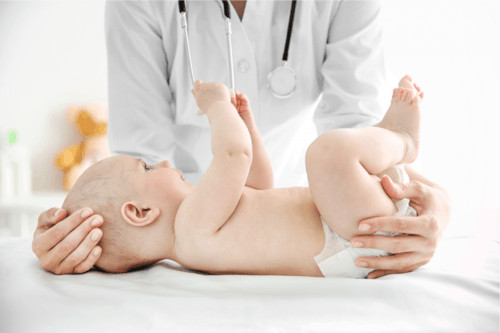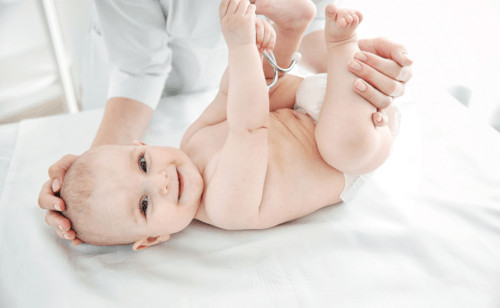Inguinal hernia
Inguinal hernia is the exit of part of the abdominal contents through an orifice that communicates with the inguinal region.
In children, inguinal hernia is a congenital anomaly, i.e. it is present from birth although sometimes it does not become apparent until some time later. Unlike hernias in adults, inguinal hernia in children is not due to a muscular defect, but to the persistence of a communication between the abdominal cavity and the inguinal region that exists during prenatal development. It is more frequent in premature boys -although it also occurs in girls- or low birth weight babies and is more commonly found on the right side.
Symptoms of inguinal hernia
Hernias are manifested as a "bulge" in the inguinal region that appears when the child cries, screams, coughs or strains with the abdomen. In doing so, the pressure in the abdominal cavity increases and part of its contents protrude through the inguinal orifice.

Usually, the herniated content is an intestinal loop, but it can also be an ovary in girls.
When the hernia is not complicated, it is easily reduced by spontaneously pushing back into the abdominal cavity when crying stops or with help. If the hernia does not reduce by spontaneously pushing back into the abdominal cavity when crying stops, it is an incarcerated (trapped) hernia that is palpable as a hard, painful area in the inguinal region.
Occasionally, the contents of the incarcerated hernia begin to suffer due to compression and difficulty in blood flow and is called a strangulated hernia. This condition is usually accompanied by vomiting, constipation and general malaise and should be evaluated urgently by a pediatric surgeon.

Diagnosis of inguinal hernia
The diagnosis of inguinal hernia is made by clinical history and physical examination, reserving ultrasonography for those patients who may be difficult to diagnose due to anatomical abnormalities or previous interventions. Although the hernia may not be present at the time of the medical visit, a thorough physical examination will identify indirect signs of the presence of an inguinal hernia.
When an inguinal hernia is suspected, the clinical examination carried out in the consultation room with detailed questioning of the parents helps to confirm the diagnosis. It is important to rule out episodes of incarceration or the presence of constipation or vomiting caused by repeated protrusion of the hernia and to help parents identify these symptoms and know what measures to take if they occur.
Treatment of inguinal hernia
The treatment of inguinal hernia is always surgical. It is not considered an urgent procedure except in situations where the hernia is irreducible or strangulated. According to the surgical calendar of the Spanish Society of Pediatric Surgery as well as the European Guidelines, these hernias should be operated when diagnosed without delaying the intervention.

Only in very premature or low birth weight newborns is it recommended to delay the intervention, if possible, to favor previous weight gain and reduce the surgical and anesthetic risk.
The surgery consists of making a small incision in the inguinal fold to find and close the communication with the abdominal cavity, separating it from the other elements of the inguinal cord that we preserve. Recovery is usually good and complications are not frequent.
Team of the inguinal hernia unit


 +34 912 627 104
+34 912 627 104 Contact
Contact







